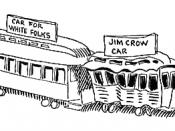Around 1914 in the United States, race relations hit arguably an all-time low in the history of civilization on the North American continent. Every Southern state had passed laws that created two separate societies; one black, the other white. Blacks and whites could not ride together in the same railroad cars, sit in the same waiting rooms, use the same washrooms, eat in the same restaurants, or sit in the same theaters. Blacks were denied access to parks, beaches, and picnic areas; they were barred from many hospitals. Segregation as a social system was begun in the North prior to the Civil War, but, during the last two decades of the nineteenth century, Southern states made it a legal requirement. What had been maintained by custom was to be strengthened by law. The "separate but equal" ideology plagued the social structure of the United States.
The popular belief that this country belonged to the white man was nothing new though.
From the moment Christopher Columbus stepped foot on this "New World" in 1492, this assumption was self-evident through the ensuing mistreatment and domination of the Native Americans by white settlers. Unfortunately, this belief only escalated over the years. Abraham Lincoln's success in the Civil War and the end of slavery sparked a new era for the Black race in America. The "Black Codes" passed following the Civil War gave Blacks equal rights in the United States. But even though they were guaranteed their freedom from slavery, the law segregated them from Whites. African Americans still stared an evil racial monster in the face called the Jim Crow Laws. These laws steamrolled any hope for dialogue of race relations with its notorious maxim "separate but equal." Much needed change finally occurred after the landmark Supreme Court case Brown v. Kansas Board...



How wonderful
this essay taught me what fuel racism and
it taught me that it has not been practiced in one place.
3 out of 3 people found this comment useful.